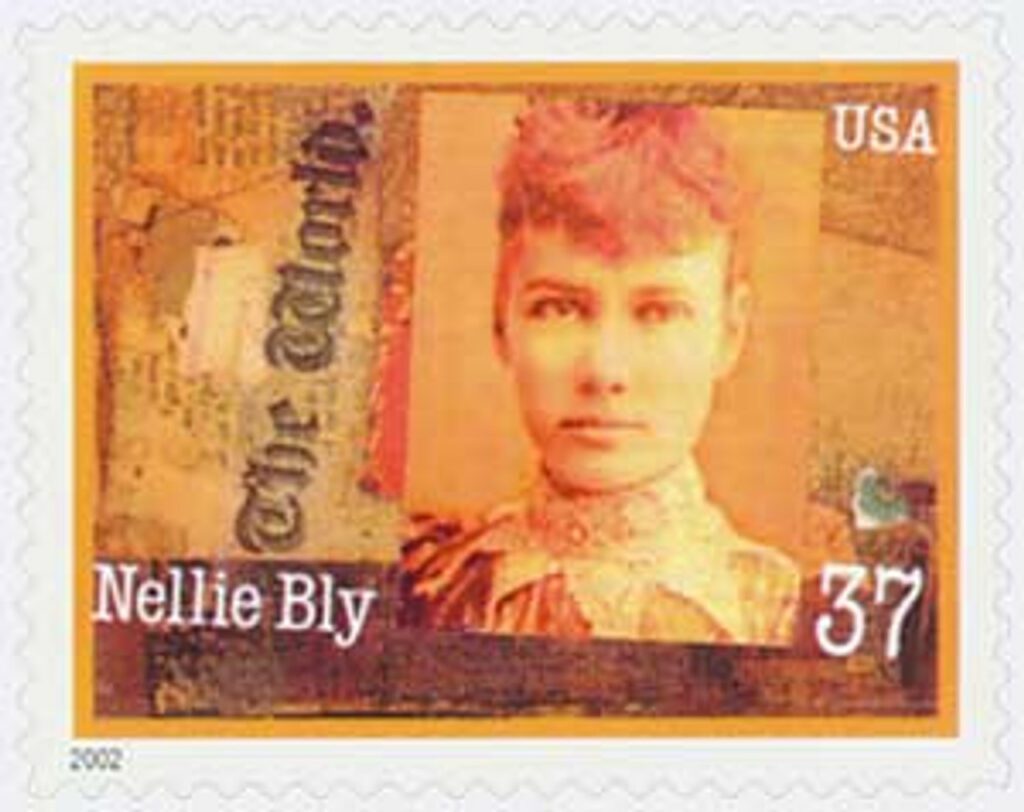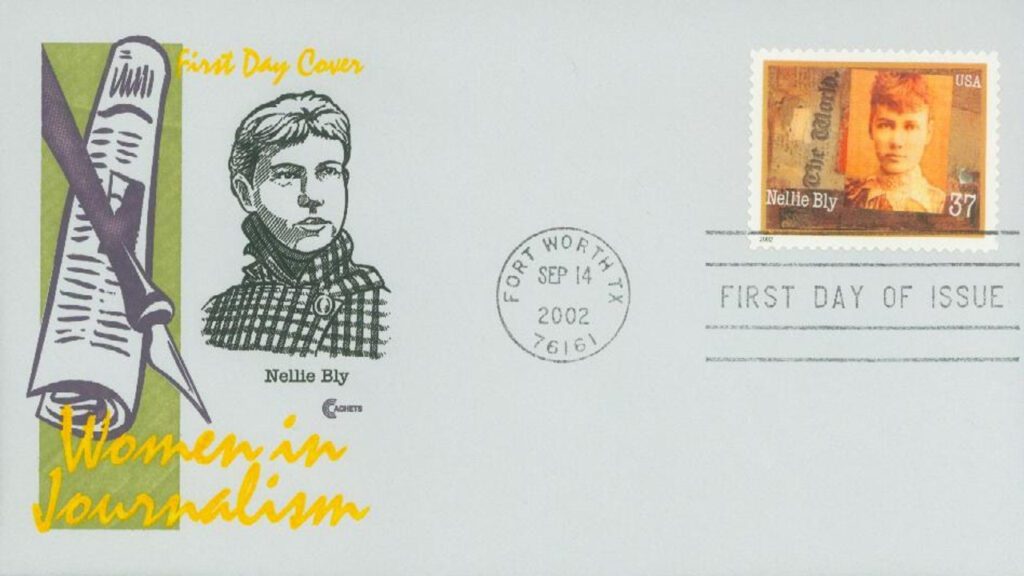Nellie Bly was born Elizabeth Jane Cochran on May 5, 1864, in Cochran’s Mills, Pennsylvania.
When she was a teenager, Bly read an offensive article in the Pittsburgh Dispatch titled, “What Girls are Good For.” She was so upset that she wrote an angry response to the editor under the name, “Lonely Orphan Girl.” The editor was so impressed he ran an advertisement asking her to reveal herself and ultimately offered her a full-time job. It was at this time that she adopted the pen name Nellie Bly, after the character in a Stephen Foster song.
Bly’s early writing focused on the difficulties of working women. But she was soon pressured to write about “women’s issues” such as fashion and gardening. Bly then spent six months in as a foreign correspondent. When she returned to the Dispatch she was again forced to write about issues she found boring so she quit and moved to New York. There she found work with the New York World and agreed to fake insanity so she could investigate alleged brutality and neglect at the Women’s Lunatic Asylum on Blackwell’s Island.
Bly put on a good act that earned her a spot in the asylum, where she witnessed the poor conditions firsthand. The women were fed spoiled food and undrinkable water; those considered dangerous were tied together; many forced to sit entire days on hard benches; rats and waste were everywhere; and nurses beat patients. Bly spoke with her fellow patients and realized some of them were as sane as she was, and could have been driven mad by the deplorable conditions. After 10 days, the World demanded her release and Bly published her story, which was later made into a book, Ten Days in a Mad-House. The asylum was then investigated and major changes followed. Bly soon enjoyed widespread fame.
In 1888, Bly suggested to her editor that she take a trip around the world, in an attempt to make the fictional trip from Jules Verne’s Around the World in Eighty Days a reality. Bly grew increasingly excited for the trip and with two days’ notice, embarked on the voyage at 9:40 a.m. on November 14, 1889. That morning, she boarded the Augusta Victoria of the Hamburg America Line to begin her 24,899-mile journey.
Around the same time, rival New York newspaper Cosmopolitan sent reporter Elizabeth Bisland to beat Bly’s time. To retain interest in her story, Bly’s paper hosted the “Nellie Bly Guessing Match” encouraging readers to guess her arrival time to the second. The grand prize was a trip to Europe with spending money. Bly traveled through England, France (where she met Jules Verne), Brindisi, the Suez Canal, Colombo, Singapore, Hong Kong, and Japan.
Through underwater cable networks and electric telegraphs, Bly was able to update her editor on her trip’s progress. Despite arriving in San Francisco two days later due to inclement weather, Bly arrived back in New Jersey at 3:51 p.m. on January 25, 1890. Her total trip was 72 days, 6 hours, 11 minutes, and 14 seconds, beating the fictional record set in Verne’s masterpiece. Bly’s rival, Bisland, had missed a connection along the way and was forced to take a slower ship, ending her chances of beating Bly. Bly’s world record was broken just a few months later by George France Train, who completed the trip in 67 days. The record was again broken in 1913, when a group of three men did it in less than 36 days.
After getting married in 1895, Bly retired from journalism and became president of the Iron Clad Manufacturing Company, which produced steel containers including milk cans and boilers. There, Bly received patents for a novel milk can and stacking garbage can. She was briefly one of the nation’s leading female industrialists, but employee embezzlement ultimately left the company bankrupt. Bly then returned to journalism, covering the Woman Suffrage Parade of 1913 and the Eastern Front during World War I. She died of pneumonia in New York City on January 27, 1922.
Click here to see (and print and play!) the “Round the World with Nellie Bly Board Game.
| FREE printable This Day in History album pages Download a PDF of today’s article. Get a binder or other supplies to create your This Day in History album. |
Click here to see what else happened on This Day in History.







Quite the individual!
Perseverance.
This is a terrific story! Who knew?
Thank you Mystic for enlightening us. This lady was quite the pioneer.
This has my “stamp” of approval!
Way to go Nellie Bly. I’m glad to know her story. Thank you
What a fascinating person and a wonderful article.
Super! This also happens to be my niece’s Birthday, who is another independent woman!
Wonderful story. Thanks!
She was quite a remarkable woman and an intrepid reporter.
After her death she was interred in Woodlawn Cemetery in The Bronx, New York.
Thanks for the story. As the father of 4 very accomplished and independent daughters, I am a huge Nellie Bly fan.
I knew a little bit about her from reading about Dorothy Kilgallen and her around the world trip in 1936. Back in Nellie’s day, she really did break the “glass ceiling “ and achieved some remarkable feats. I think she showed the world a woman can achieve just like guys can! I still believe that Dorothy Kilgallen should have a commemorative stamp as well! Thanks again for a wonderful read!
Great article about a great stamp from a great 2002 issue. These are my particular favorite set from the ’00 decade. I know Nellie from 10 Days in a Madhouse but the rest of the story is just as remarkable. Thanks Mystic for great daily stamp expos!
Nellie Bly gave it a try, discovered she could beat any ole Guy.